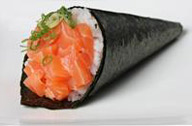The other day I went to a Japanese restaurant for a
snack.
 |
| Small order - Temaki |
 |
| Large order - Combinado |
I was very hungry and wanted something simple and fast. I ordered one temaki. Unfortunately, it took me more than 30 minutes to get my temaki. Needless to day, I left the restaurant very frustrated and unhappy with the service.
After a few months, I went back to the restaurant and took a look at their kanban system. I noticed that all orders follow a single queue.
Let me explain the restaurant simple workflow: The waiter collects the order, and then he places it on the suchiman queue. Once the suchiman finishes working on the current order, he picks up the next one from the queue. The drawing below replicates the scenario that happened when I ordered a temaki.
 |
| Single Queue |
My temaki order is the last one on the queue. It has a small line, representing a small snack. The orders in front of it have more lines, representing larger orders.
Consider that each large order takes approximately 10 minutes, and that a small order (my temaki) takes one minute.
Following the single queue workflow my order did take
more than 30 minutes.
Let's now use the same workflow (with the same style of visual management and order control), but with a small change: two queues instead of a single one. Temaki and simple appetizer goes through the small order queue; everything else goes through the large order queue.
 |
| Dual Queue |
Consider that the restaurant changes from a single order queue to the model
represented above. Also, the suchiman gives priority to small order instead of
starting on a large one.
By following this model, my temaki wait time would
have reduced substantially. It would be
at most 11 minutes, instead of at most 41 minutes.
This illustrates the dual queue concept. I am sure you
can relate to it and can name quite a few places you have seen it (or missed it) before.